Expert Q&A: Dr. Ray Semlitsch
By Amy Nelson
Dr. Ray Semlitsch
Curators Professor of Biological Sciences
University of Missouri
 One day back in the 1970s, Dr. James Spotila, a biology professor at State University College at Buffalo, shared a paper he had just published on lungless salamanders with a young undergrad named Ray Semlitsch. Little did Dr. Spotila know that in that moment, he sparked in Ray what would become a lifelong fascination with salamanders, and a 30-year career centered on amphibian ecology and wetland conservation.
One day back in the 1970s, Dr. James Spotila, a biology professor at State University College at Buffalo, shared a paper he had just published on lungless salamanders with a young undergrad named Ray Semlitsch. Little did Dr. Spotila know that in that moment, he sparked in Ray what would become a lifelong fascination with salamanders, and a 30-year career centered on amphibian ecology and wetland conservation.
Today, Ray Semlitsch is himself a professor. As Curators’ Professor of Biological Sciences at the University of Missouri, he conducts research and mentors graduate students in work that highlights the importance of the terrestrial environment surrounding wetlands and headwater streams as essential “core habitat” for conservation and management of amphibians.
Dr. Semlitsch has published several books, including Amphibian Conservation by Smithsonian Press, 25 book chapters and newsletter articles, and more than 220 scientific journal papers concerning the ecology of amphibians and other semi-aquatic species, and the value of head-water streams and small isolated wetlands. He was also a co-author of “Where Rivers are Born: The Scientific Imperative for Defending Small Streams and Wetlands” that argues against the highly controversial SWANCC court decision. He has received numerous awards, including the National Wetlands Award for Science Research from The Environmental Law Institute and the Henry Fitch Award for Excellence in Herpetology from the American Society of Ichthyologists and Herpetologists.
To give our readers a sense of the incredible diversity found in salamanders, can you tell us about two or three very different species, and some of their attributes you find most fascinating?

There is enormous diversity in the appearance and life cycles of salamanders. There are two that I find particularly fascinating, partly because they are rare. One is the fire salamander group in Europe. There are several species. Salamandra salamandra, is the traditional fire salamander that gives birth to larvae in water and has aquatic larval development, which is very typical. But there is a sister species that occurs at higher elevations, up to 2,800 meters—Salamandra atra, which is the only species of salamander in the world that gives birth to fully developed live young on land.
Other fascinating salamanders are paedomorphic salamanders, (such as the mole salamander, Ambystoma talpoideum). They have the ability to reproduce in the aquatic larval phase without undergoing metamorphosis. They maintain larval morphology, but they become reproductively mature. An extreme example is the Mexican axolotl, Ambystoma mexicanum, that has lost the ability to metamorphose and only lives in stable aquatic habitats.
I understand that the U.S. has more species than any other country and is considered a biodiversity hotspot. What part of the world has the next highest number of species?
Historically, the southern Appalachians (in the U.S.) has been the area of highest biodiversity in the world, but over the last few decades, the Guatemalan Highlands of Central America has equaled that or may now be greater. Studies led by David Wake at the University of California, Berkeley, have led to the discovery of more and more species there. Those two areas are the biodiversity hotspots.
Salamanders are often described as being like the ‘canary in a coal mine.’ In what ways do salamanders serve as bioindicators?

One of the fascinating things about salamanders, which is both good and bad, is that they typically require fairly pristine habitats. Aquatic species require very clean water. Terrestrial species often require pristine, old-growth forest habitat. When there is some impact that degrades the quality of aquatic or terrestrial habitat, salamanders are often the first group to drop out. In general, they are even more sensitive than frogs. They are the first to be affected by anthropogenic effects.
Can you give an example of a situation where salamanders were, in disappearing, essentially screaming that there was a problem, but it went unnoticed and there was a cascading effect.
There really is not a lot of historical documentation of decline. A lot of habitat reduction occurred when Europeans cleared the forest. Every tree east of the Mississippi has been cut once, if not twice, over the last two centuries. If you think about species that are forest dependent, my guess is that they’ve been affected. But that was before people were doing scientific studies. We do know, however, that in big agricultural states like Missouri, Illinois, and Indiana, where a large portion of the trees have been cleared, species like the tiger salamander, which were once widespread in the Midwestern U.S., are now very rare.
You recently published a study that addresses the importance of salamander biomass, nutrient, and energy flux to the function of forest ecosystems in the Missouri Ozarks. Can you tell us about this study, and what you found?
That study was really a follow up of a study that was done in the 1970s in the Hubbard Brook Experimental Forest in New Hampshire. (1975a, Ecology, 56: 1068–1080; 1975b, Copeia, 1975: 541–546). We have known for a long time that these little, terrestrial red-backed salamanders (genus: Plethodon) occur in forested areas all over the U.S., but we assumed that they were more abundant than the studies in the 1970s found.

We went into our study with the intention of coming up with really good density and biomass estimates and that’s exactly what we found. They are actually two to four times higher than was previously recorded in New Hampshire. When you use a robust estimate of abundance, you find that density and biomass estimates are higher.
From that, we extended the information to biomass and nutrients. You can make an argument from these data that if they’re producing more biomass and more nutrients than we thought, they may be more important, in terms of ecosystem function and energy flow, than previously thought. We had been assuming that all along, but these findings reinforce that assumption.
So this seems like an important step in building the case for salamander conservation based on their importance to forest ecosystem function. What is the next step?

At this point, we have hypotheses about the role of salamanders in forest ecosystems, but we really don’t have the scientific evidence to establish that role. The first step is determining what is out there, how many are out there, and what the biomass and nutrients are. The next step is looking at how they move that biomass and nutrients between different components of the forest. Salamanders are predators. They eat forest invertebrates. We need to know how many forest invertebrates they eat, whether they have an impact on the density of forest invertebrates. Then, we need to understand how that cascades into those invertebrates eating either more or less leaf litter, which ties to the trees, which ties to the forest. That’s the sort of ecosystem-level analysis we need.
Is there a way to estimate the percent of biomass that salamanders generally comprise in forest ecosystems?
Looking at salamander biomass per meter square or per acre, our estimates indicate that it’s higher than white-tailed deer in the Ozarks. Here in Missouri, we have a white-tailed deer population of something like 1.2 to 1.4 million. The studies in [the Hubbard Brook Experimental Forest in New Hampshire]actually found a similar thing: that salamander biomass was higher there than the mammal and bird biomass.
Sadly, not everyone understands or appreciates the importance of biodiversity and ecosystem integrity. In what other ways are salamanders considered important—ways people may not know about?
We think salamanders are important in terms of production of nutrients and energy, but that’s a hard concept to convey to the general public. Salamanders eat insects that eat leaf litter, so they’re involved in carbon sequestration. You could make a strong case that salamanders may be important in terms of how much carbon is stored versus how much is released as carbon dioxide in the air. Those studies need to be done.
In terms of biodiversity, I sometimes use the analogy of the “rivet theory.” If you’re sitting in an airplane and you look out onto the wing of the plane, you see that there are thousands of rivets holding the wing together. If you see one missing out of ten thousand, you wouldn’t be alarmed. But if you looked out and noticed that there were 10 or 20 missing, would you start to get worried that the wing might fall off of the airplane? If you think of rivets as species, the question becomes “How many species can we lose before the wing falls off (or the ecosystem collapses).” When people talk about extinctions, they’re usually talking about single species extinction, and they often ask, “Why does [the loss of a single species] matter?” Well, it’s the sum of the species and their role in the ecosystem that really is important.
What about salamanders’ importance in other areas, such as medical research?
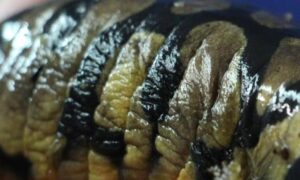
Salamanders have granular glands in the skin which, in some cases, secrete anti-predator secretions and/or anti-fungal compounds. They live in the ground, and are surrounded by fungi, you’d think their skin would be affected, but they have a lot of anti-fungal qualities. There is a huge effort looking into what that might tell us about medicinal compounds for human health.
Salamanders have also been used for the study of development and limb regeneration for over a century. Amphibians in general can regenerate limbs, toes, and other parts of their bodies. If you cut the toes off of a young salamander, within a year or two, it will regenerate those toes completely. There are many cases where limbs have been bitten off by predators and then become completely regenerated. If we can discover that process of how salamanders regenerate whole limbs, imagine what effect that might have on our medical field.
I read that around half of the world’s salamander species are listed as Threatened by IUCN. The chytrid fungus Batrachochytrium salamandrivorans strikes me as one of the most pressing threats. Given globalization, and the inability to isolate salamander populations, how can salamanders best be protected from this fungus?
Diseases have been around for a long time. In natural systems, they ebb and wane, and that’s a natural part of population dynamics. But when humans enter into the equation, it’s different. We’re moving things all over the planet now. Stopping that movement is a critical piece. We need heavy regulation of the pet trade and movement of animals across borders.
What are some of the other factors threatening salamanders, and what do you consider to be the greatest threat?
There are six primary threats: habitat loss and alteration, chemical contamination, global climate change, disease, invasive species, and commercial exploitation. That’s true of all biodiversity on the planet.
 The most important and devastating has been habitat loss and alteration. There is absolutely no doubt that humans have modified habitat all over the planet. The problem is that we don’t view it that way because it’s been that way our entire lives. A lot of other threats, like global climate change, are more contemporary, and are now layered on top of habitat loss. So they are right in our face, and we tend to think they’re more important, but in terms of global effect, habitat loss is number one.
The most important and devastating has been habitat loss and alteration. There is absolutely no doubt that humans have modified habitat all over the planet. The problem is that we don’t view it that way because it’s been that way our entire lives. A lot of other threats, like global climate change, are more contemporary, and are now layered on top of habitat loss. So they are right in our face, and we tend to think they’re more important, but in terms of global effect, habitat loss is number one.
What measures can federal/state/local agencies enact to have the greatest impact on the survival of salamanders? Do you know of any cases where effective action was taken by any government to protect salamanders?
The number one measure that could be taken would be to protect or restore habitat. In the Midwest, the loss of wetlands has become a huge problem for species that require wetlands for breeding. Restoring those wetlands in some kind of natural configuration of wetlands across the landscape would do more to increase the size of populations and bring them back to stable levels than anything.
Does your lab get involved in habitat restoration projects?
 Our lab really focuses on the development and testing of techniques that could be used in management and restoration. We have a grant from the Department of Defense right now to develop management guidelines for salamanders across the entire U.S. The things we are measuring here Missouri, we’re doing it in such a way that we can generalize to pond breeding species throughout the U.S. We’ll make recommendations on what we think needs to be done, but then it is up to the local, state, or federal agencies to adopt those plans. We don’t restore wetlands, but we’ve done studies that show how it needs to be done and what parameters of wetlands are important.
Our lab really focuses on the development and testing of techniques that could be used in management and restoration. We have a grant from the Department of Defense right now to develop management guidelines for salamanders across the entire U.S. The things we are measuring here Missouri, we’re doing it in such a way that we can generalize to pond breeding species throughout the U.S. We’ll make recommendations on what we think needs to be done, but then it is up to the local, state, or federal agencies to adopt those plans. We don’t restore wetlands, but we’ve done studies that show how it needs to be done and what parameters of wetlands are important.
Is there one level of government you believe can have the greatest impact?
I don’t think so. What is most important is that there is collaboration between federal, state, and local agencies. There may be strong protection of a particular species in one state, but when you cross the boundary into another state, there is no protection. Or you may have very tight wetland mitigation regulations in one state but not in the neighboring state. These agencies need to understand that species cross these political boundaries, and they need to work together.
In 2013, you co-authored a study in Conservation Biology related to salamander recovery rates following timber harvests. What were the key findings of that study, and how might they inform forest management or restoration work?
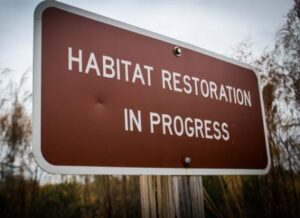 There were two take-home messages. The first is not a new one: salamander populations take decades to recover to pre-cut levels after timber harvests. The second key finding was that recovery depends on species vagility. Species that move more as part of their lifecycle (e.g., migrate back and forth between the forest and the stream) tend to recover faster than species that don’t. Species that do not have that migratory ability tend to take 100 years to recover, while those that move on a regular basis tend to recover in 50-60 years. So the key finding is that species are important, and you cannot treat all salamanders the same.
There were two take-home messages. The first is not a new one: salamander populations take decades to recover to pre-cut levels after timber harvests. The second key finding was that recovery depends on species vagility. Species that move more as part of their lifecycle (e.g., migrate back and forth between the forest and the stream) tend to recover faster than species that don’t. Species that do not have that migratory ability tend to take 100 years to recover, while those that move on a regular basis tend to recover in 50-60 years. So the key finding is that species are important, and you cannot treat all salamanders the same.
What other studies do you have underway now that could inform the work of our readers?
Our focus has shifted to landscape ecology. We’re trying to understand the spatial structure and dynamics of salamander populations across the landscape. In the past, our studies and other studies focused more on single populations, or a few populations of salamanders. In our current study for the Department of Defense, we’re studying 200 breeding ponds over a fairly large area and we’re trying to understand how they are connected to one another, in terms of their demography, population biology, or movement (including movement of individuals between populations.) It doesn’t do us much good to put a lot of effort into recovering a single population when we don’t even understand the role of that population in a bigger landscape. Populations don’t function independently; there are demographic connections that we need to understand for developing effective conservation and management solutions.
How exactly do you study nocturnal, secretive creatures at 200 breeding ponds?
 I have a large group of graduate students! I have had as many as eight PhD students who, during certain periods of the year, work nonstop for weeks at a time. We go out to each pond and census the pond for salamander larvae, which we assume is the result of reproduction by adult populations. There is a lot of background information that we know about these species. When we study the larvae, and we come up with robust estimates of abundance for each pond over time, then we can say something about the ability of that pond to persist in the landscape and also use that information to come up with something we call the “contribution” of that pond to the greater landscape.
I have a large group of graduate students! I have had as many as eight PhD students who, during certain periods of the year, work nonstop for weeks at a time. We go out to each pond and census the pond for salamander larvae, which we assume is the result of reproduction by adult populations. There is a lot of background information that we know about these species. When we study the larvae, and we come up with robust estimates of abundance for each pond over time, then we can say something about the ability of that pond to persist in the landscape and also use that information to come up with something we call the “contribution” of that pond to the greater landscape.
We need to understand what the contribution is from individual populations, and then try to put that together in a larger network. We are using a lot of (mathematical) modeling techniques where we model abundance and then take that abundance and make it spacially explicit (pond specific). We put it into what’s called a “network model.” Network models have been used for years. That’s how cell phone tower placement is determined, for example. If they spend a million dollars to build a cell phone tower, they need to know where it will be most effective in increasing the strength of the network. We’re trying to understand the same thing. Where is the pond located? Where could a pond be located or restored so that it increases the strength of the network of the salamander population?
How long a study is this?
We have just finished the third year, and we may get a fourth. We are trying to pull three years of data together and generate information that can be used by other DOD sites and other places in the U.S. We have begun working with the Flatwoods Salamander Working Group (headed by Dr. Susan Walls, USGS) in the panhandle of Florida to use our results to better inform a restoration and recovery plan for these endangered species.
How can our readers stay up to date on this study?
Our lab web site posts everything that is published. The DOD funding agency for this study is the Strategic Environmental Research and Development Program (SERDP), and our project is posted there as well.
I read about a species that was newly discovered in 2007 by two grad students (including one from your school) in Georgia. I read of another species discovery in 2011 in Arkansas and in two more in 2013 near the border of Colombia and Venezuela. How often do these discoveries occur?
Among amphibians, new discoveries happen every day. There are two key reasons. One is that the species “discovered” are often actually cryptic species, species you cannot identify by eye. Until recently, traditional methods have not been adequate for separating one species from another. With the advent of high-resolution, molecular genetics, however, new species are being identified on a regular basis. The other way in which they are discovered is that we are going into places where people have not been. That is the case in many places in Asia, such as Indonesia.

In the case of the salamander discovery in Georgia, that was actually not a new species, but a new genus! That is rare, and absolutely spectacular. One of my grad students, Bill Peterman (currently a post-doc at the University of Illinois, Illinois Natural History Survey), was collaborating with another grad student at the University of Georgia. They were out on a field trip and they wanted to check out this particular area and that’s where they found it.
The site was in a ravine, which had probably been protected from land use. I have been to the site. It was probably surrounded by agriculture, and although the hills and ridges surrounding the ravine were not farmed, they were probably logged. But this salamander [named Urspelerpes brucei)]is aquatic, and lives down in the water of the mountain streams at the bottom of the ravine, so they’ve been protected. My guess is that hundreds of years ago, before settlement, it probably occurred throughout that region, and with land use, its habitat has been contracted to this one area. Originally the students thought it was a new species, but then David Wake (University of California Berkeley) did a morphological analyses and Trip Lamb (Eastern Carolina University) did the genetics on it, they realized it was a new genus.
It’s a thrilling discovery, but it is also heartbreaking because there were probably dozens of other species that were eliminated during settlement periods.
Do you have hope for salamanders? If so, what gives you hope?

I’m fairly certain that salamanders play a functional role in aquatic and forest ecosystems. I think if they disappear, we’re in pretty serious trouble. The disappearance of salamanders would say something about the initial collapse of ecosystems like we’ve never seen. From a biology perspective, and from the perspective of someone who is pretty curious about nature in general, I also think they’re one of the coolest animals on the planet.
 Dr. Semlitsch has published several books, including Amphibian Conservation by Smithsonian Press, 25 book chapters and newsletter articles, and more than 220 scientific journal papers concerning the ecology of amphibians and other semi-aquatic species, and the value of head-water streams and small isolated wetlands. He was also a co-author of “Where Rivers are Born: The Scientific Imperative for Defending Small Streams and Wetlands” that argues against the highly controversial SWANCC court decision. He has received numerous awards, including the National Wetlands Award for Science Research from The Environmental Law Institute and the Henry Fitch Award for Excellence in Herpetology from the American Society of Ichthyologists and Herpetologists.
Dr. Semlitsch has published several books, including Amphibian Conservation by Smithsonian Press, 25 book chapters and newsletter articles, and more than 220 scientific journal papers concerning the ecology of amphibians and other semi-aquatic species, and the value of head-water streams and small isolated wetlands. He was also a co-author of “Where Rivers are Born: The Scientific Imperative for Defending Small Streams and Wetlands” that argues against the highly controversial SWANCC court decision. He has received numerous awards, including the National Wetlands Award for Science Research from The Environmental Law Institute and the Henry Fitch Award for Excellence in Herpetology from the American Society of Ichthyologists and Herpetologists.
To give our readers a sense of the incredible diversity found in salamanders, can you tell us about two or three very different species, and some of their attributes you find most fascinating?
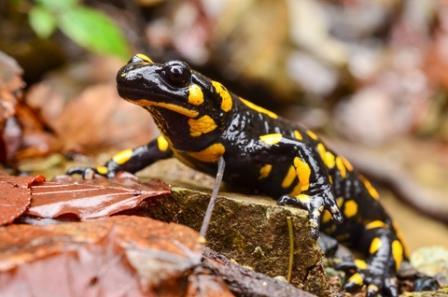
There is enormous diversity in the appearance and life cycles of salamanders. There are two that I find particularly fascinating, partly because they are rare. One is the fire salamander group in Europe. There are several species. Salamandra salamandra, is the traditional fire salamander that gives birth to larvae in water and has aquatic larval development, which is very typical. But there is a sister species that occurs at higher elevations, up to 2,800 meters—Salamandra atra, which is the only species of salamander in the world that gives birth to fully developed live young on land.
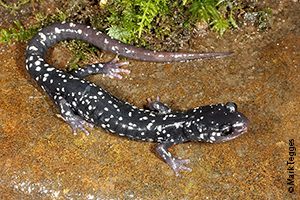
Other fascinating salamanders are paedomorphic salamanders, (such as the mole salamander, Ambystoma talpoideum). They have the ability to reproduce in the aquatic larval phase without undergoing metamorphosis. They maintain larval morphology, but they become reproductively mature. An extreme example is the Mexican axolotl, Ambystoma mexicanum, that has lost the ability to metamorphose and only lives in stable aquatic habitats.
I understand that the U.S. has more species than any other country and is considered a biodiversity hotspot. What part of the world has the next highest number of species?
Historically, the southern Appalachians (in the U.S.) has been the area of highest biodiversity in the world, but over the last few decades, the Guatemalan Highlands of Central America has equaled that or may now be greater. Studies led by David Wake at the University of California, Berkeley, have led to the discovery of more and more species there. Those two areas are thebiodiversity hotspots.
Salamanders are often described as being like the ‘canary in a coal mine.’ In what ways do salamanders serve as bioindicators?
One of the fascinating things about salamanders, which is both good and bad, is that they typically require fairly pristine habitats. Aquatic species require very clean water. Terrestrial species often require pristine, old-growth forest habitat. When there is some impact that degrades the quality of aquatic or terrestrial habitat, salamanders are often the first group to drop out. In general, they are even more sensitive than frogs. They are the first to be affected by anthropogenic effects.
Can you give an example of a situation where salamanders were, in disappearing, essentially screaming that there was a problem, but it went unnoticed and there was a cascading effect.
There really is not a lot of historical documentation of decline. A lot of habitat reduction occurred when Europeans cleared the forest. Every tree east of the Mississippi has been cut once, if not twice, over the last two centuries. If you think about species that are forest dependent, my guess is that they’ve been affected. But that was before people were doing scientific studies. We do know, however, that in big agricultural states like Missouri, Illinois, and Indiana, where a large portion of the trees have been cleared, species like the tiger salamander, which were once widespread in the Midwestern U.S., are now very rare.
You recently published a study that addresses the importance of salamander biomass, nutrient, and energy flux to the function of forest ecosystems in the Missouri Ozarks. Can you tell us about this study, and what you found?
That study was really a follow up of a study that was done in the 1970s in the Hubbard Brook Experimental Forest in New Hampshire. (1975a, Ecology, 56: 1068–1080; 1975b, Copeia, 1975: 541–546). We have known for a long time that these little, terrestrial red-backed salamanders (genus: Plethodon) occur in forested areas all over the U.S., but we assumed that they were more abundant than the studies in the 1970s found.
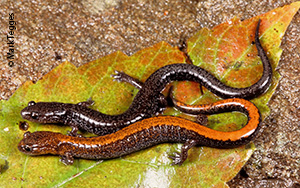
We went into our study with the intention of coming up with really good density and biomass estimates and that’s exactly what we found. They are actually two to four times higher than was previously recorded in New Hampshire. When you use a robust estimate of abundance, you find that density and biomass estimates are higher.
From that, we extended the information to biomass and nutrients. You can make an argument from these data that if they’re producing more biomass and more nutrients than we thought, they may be more important, in terms of ecosystem function and energy flow, than previously thought. We had been assuming that all along, but these findings reinforce that assumption.
So this seems like an important step in building the case for salamander conservation based on their importance to forest ecosystem function. What is the next step?
We went into our study with the intention of coming up with really good density and biomass estimates and that’s exactly what we found. They are actually two to four times higher than was previously recorded in New Hampshire. When you use a robust estimate of abundance, you find that density and biomass estimates are higher.
From that, we extended the information to biomass and nutrients. You can make an argument from these data that if they’re producing more biomass and more nutrients than we thought, they may be more important, in terms of ecosystem function and energy flow, than previously thought. We had been assuming that all along, but these findings reinforce that assumption.
So this seems like an important step in building the case for salamander conservation based on their importance to forest ecosystem function. What is the next step?
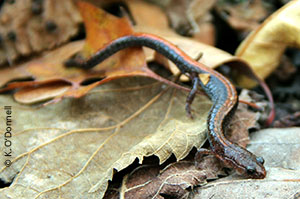
At this point, we have hypotheses about the role of salamanders in forest ecosystems, but we really don’t have the scientific evidence to establish that role. The first step is determining what is out there, how many are out there, and what the biomass and nutrients are. The next step is looking at how they move that biomass and nutrients between different components of the forest. Salamanders are predators. They eat forest invertebrates. We need to know how many forest invertebrates they eat, whether they have an impact on the density of forest invertebrates. Then, we need to understand how that cascades into those invertebrates eating either more or less leaf litter, which ties to the trees, which ties to the forest. That’s the sort of ecosystem-level analysis we need.
Is there a way to estimate the percent of biomass that salamanders generally comprise in forest ecosystems?
Looking at salamander biomass per meter square or per acre, our estimates indicate that it’s higher than white-tailed deer in the Ozarks. Here in Missouri, we have a white-tailed deer population of something like 1.2 to 1.4 million. The studies in [the Hubbard Brook Experimental Forest in New Hampshire]actually found a similar thing: that salamander biomass was higher there than the mammal and bird biomass.
Sadly, not everyone understands or appreciates the importance of biodiversity and ecosystem integrity. In what other ways are salamanders considered important—ways people may not know about?
We think salamanders are important in terms of production of nutrients and energy, but that’s a hard concept to convey to the general public. Salamanders eat insects that eat leaf litter, so they’re involved in carbon sequestration. You could make a strong case that salamanders may be important in terms of how much carbon is stored versus how much is released as carbon dioxide in the air. Those studies need to be done.
In terms of biodiversity, I sometimes use the analogy of the “rivet theory.” If you’re sitting in an airplane and you look out onto the wing of the plane, you see that there are thousands of rivets holding the wing together. If you see one missing out of ten thousand, you wouldn’t be alarmed. But if you looked out and noticed that there were 10 or 20 missing, would you start to get worried that the wing might fall off of the airplane? If you think of rivets as species, the question becomes “How many species can we lose before the wing falls off (or the ecosystem collapses).” When people talk about extinctions, they’re usually talking about single species extinction, and they often ask, “Why does [the loss of a single species] matter?” Well, it’s the sum of the species and their role in the ecosystem that really is important.
What about salamanders’ importance in other areas, such as medical research?
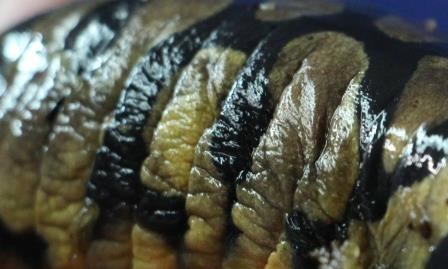
Salamanders have granular glands in the skin which, in some cases, secrete anti-predator secretions and/or anti-fungal compounds. They live in the ground, and are surrounded by fungi, you’d think their skin would be affected, but they have a lot of anti-fungal qualities. There is a huge effort looking into what that might tell us about medicinal compounds for human health.
Salamanders have also been used for the study of development and limb regeneration for over a century. Amphibians in general can regenerate limbs, toes, and other parts of their bodies. If you cut the toes off of a young salamander, within a year or two, it will regenerate those toes completely. There are many cases where limbs have been bitten off by predators and then become completely regenerated. If we can discover that process of how salamanders regenerate whole limbs, imagine what effect that might have on our medical field.
I read that around half of the world’s salamander species are listed as Threatened by IUCN. The chytrid fungus Batrachochytrium salamandrivorans strikes me as one of the most pressing threats. Given globalization, and the inability to isolate salamander populations, how can salamanders best be protected from this fungus?
Diseases have been around for a long time. In natural systems, they ebb and wane, and that’s a natural part of population dynamics. But when humans enter into the equation, it’s different. We’re moving things all over the planet now. Stopping that movement is a critical piece. We need heavy regulation of the pet trade and movement of animals across borders.
What are some of the other factors threatening salamanders, and what do you consider to be the greatest threat?
There are six primary threats: habitat loss and alteration, chemical contamination, global climate change, disease, invasive species, and commercial exploitation. That’s true of all biodiversity on the planet.
The most important and devastating has been habitat loss and alteration. There is absolutely no doubt that humans have modified habitat all over the planet. The problem is that we don’t view it that way because it’s been that way our entire lives. A lot of other threats, like global climate change, are more contemporary, and are now layered on top of habitat loss. So they are right in our face, and we tend to think they’re more important, but in terms of global effect, habitat loss is number one.
What measures can federal/state/local agencies enact to have the greatest impact on the survival of salamanders? Do you know of any cases where effective action was taken by any government to protect salamanders?
The number one measure that could be taken would be to protect or restore habitat. In the Midwest, the loss of wetlands has become a huge problem for species that require wetlands for breeding. Restoring those wetlands in some kind of natural configuration of wetlands across the landscape would do more to increase the size of populations and bring them back to stable levels than anything.
Does your lab get involved in habitat restoration projects?
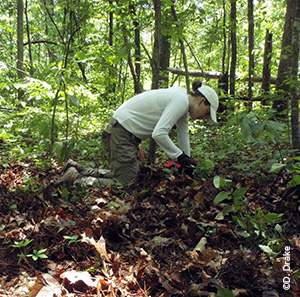
Our lab really focuses on the development and testing of techniques that could be used in management and restoration. We have a grant from the Department of Defense right now to develop management guidelines for salamanders across the entire U.S. The things we are measuring here Missouri, we’re doing it in such a way that we can generalize to pond breeding species throughout the U.S. We’ll make recommendations on what we think needs to be done, but then it is up to the local, state, or federal agencies to adopt those plans. We don’t restore wetlands, but we’ve done studies that show how it needs to be done and what parameters of wetlands are important.
Is there one level of government you believe can have the greatest impact?
I don’t think so. What is most important is that there is collaboration between federal, state, and local agencies. There may be strong protection of a particular species in one state, but when you cross the boundary into another state, there is no protection. Or you may have very tight wetland mitigation regulations in one state but not in the neighboring state. These agencies need to understand that species cross these political boundaries, and they need to work together.
In 2013, you co-authored a study in Conservation Biology related to salamander recovery rates following timber harvests. What were the key findings of that study, and how might they inform forest management or restoration work?
There were two take-home messages. The first is not a new one: salamander populations take decades to recover to pre-cut levels after timber harvests. The second key finding was that recovery depends on species vagility. Species that move more as part of their lifecycle (e.g., migrate back and forth between the forest and the stream) tend to recover faster than species that don’t. Species that do not have that migratory ability tend to take 100 years to recover, while those that move on a regular basis tend to recover in 50-60 years. So the key finding is that species are important, and you cannot treat all salamanders the same.
What other studies do you have underway now that could inform the work of our readers?
Our focus has shifted to landscape ecology. We’re trying to understand the spatial structure and dynamics of salamander populations across the landscape. In the past, our studies and other studies focused more on single populations, or a few populations of salamanders. In our current study for the Department of Defense, we’re studying 200 breeding ponds over a fairly large area and we’re trying to understand how they are connected to one another, in terms of their demography, population biology, or movement (including movement of individuals between populations.) It doesn’t do us much good to put a lot of effort into recovering a single population when we don’t even understand the role of that population in a bigger landscape. Populations don’t function independently; there are demographic connections that we need to understand for developing effective conservation and management solutions.
How exactly do you study nocturnal, secretive creatures at 200 breeding ponds?
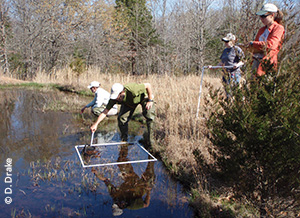
I have a large group of graduate students! I have had as many as eight PhD students who, during certain periods of the year, work nonstop for weeks at a time. We go out to each pond and census the pond for salamander larvae, which we assume is the result of reproduction by adult populations. There is a lot of background information that we know about these species. When we study the larvae, and we come up with robust estimates of abundance for each pond over time, then we can say something about the ability of that pond to persist in the landscape and also use that information to come up with something we call the “contribution” of that pond to the greater landscape.
We need to understand what the contribution is from individual populations, and then try to put that together in a larger network. We are using a lot of (mathematical) modeling techniques where we model abundance and then take that abundance and make it spacially explicit (pond specific). We put it into what’s called a “network model.” Network models have been used for years. That’s how cell phone tower placement is determined, for example. If they spend a million dollars to build a cell phone tower, they need to know where it will be most effective in increasing the strength of the network. We’re trying to understand the same thing. Where is the pond located? Where could a pond be located or restored so that it increases the strength of the network of the salamander population?
How long a study is this?
We have just finished the third year, and we may get a fourth. We are trying to pull three years of data together and generate information that can be used by other DOD sites and other places in the U.S. We have begun working with the Flatwoods Salamander Working Group (headed by Dr. Susan Walls, USGS) in the panhandle of Florida to use our results to better inform a restoration and recovery plan for these endangered species.
How can our readers stay up to date on this study?
Our lab web site posts everything that is published. The DOD funding agency for this study is the Strategic Environmental Research and Development Program (SERDP), and our project is posted there as well.
I read about a species that was newly discovered in 2007 by two grad students (including one from your school) in Georgia. I read of another species discovery in 2011 in Arkansas and in two more in 2013 near the border of Colombia and Venezuela. How often do these discoveries occur?
Among amphibians, new discoveries happen every day. There are two key reasons. One is that the species “discovered” are often actually cryptic species, species you cannot identify by eye. Until recently, traditional methods have not been adequate for separating one species from another. With the advent of high-resolution, molecular genetics, however, new species are being identified on a regular basis. The other way in which they are discovered is that we are going into places where people have not been. That is the case in many places in Asia, such as Indonesia.
In the case of the salamander discovery in Georgia, that was actually not a new species, but a new genus! That is rare, and absolutely spectacular. One of my grad students, Bill Peterman (currently a post-doc at the University of Illinois, Illinois Natural History Survey), was collaborating with another grad student at the University of Georgia. They were out on a field trip and they wanted to check out this particular area and that’s where they found it.
The site was in a ravine, which had probably been protected from land use. I have been to the site. It was probably surrounded by agriculture, and although the hills and ridges surrounding the ravine were not farmed, they were probably logged. But this salamander [named Urspelerpes brucei)]is aquatic, and lives down in the water of the mountain streams at the bottom of the ravine, so they’ve been protected. My guess is that hundreds of years ago, before settlement, it probably occurred throughout that region, and with land use, its habitat has been contracted to this one area. Originally the students thought it was a new species, but then David Wake (University of California Berkeley) did a morphological analyses and Trip Lamb (Eastern Carolina University) did the genetics on it, they realized it was a new genus.
It’s a thrilling discovery, but it is also heartbreaking because there were probably dozens of other species that were eliminated during settlement periods.
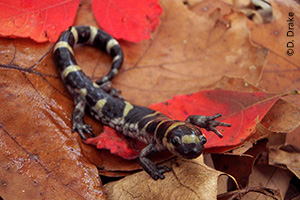
Do you have hope for salamanders? If so, what gives you hope?
I’m fairly certain that salamanders play a functional role in aquatic and forest ecosystems. I think if they disappear, we’re in pretty serious trouble. The disappearance of salamanders would say something about the initial collapse of ecosystems like we’ve never seen. From a biology perspective, and from the perspective of someone who is pretty curious about nature in general, I also think they’re one of the coolest animals on the planet.
